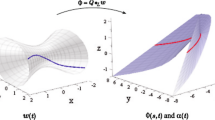Abstract
A translational surface is a rational tensor product surface generated from two rational space curves by translating one curve along the other curve. Translational surfaces can also be generated from two rational space curves by dual quaternion multiplication. Using the mathematics of dual quaternions, we provide a necessary and sufficient condition for a rational tensor product surface to be a translational surface. Examples are provided to illustrate our theorems and flesh out our algorithms.
Similar content being viewed by others
References
Altman, S.L.: Rotations, Quaternions, and Double Groups. Dover Publications, Mineola (1986)
Clifford, W.K.: Preliminary sketch of bi-quaternions. Proc. Lond. Math. Soc. 1–4, 381–395 (1873)
Dai, J.S.: An historical review of the theoretical development of rigid body displacements from rodrigues parameters to the finite twist. Mech. Mach. Theory 41, 41–52 (2006)
Daniilidis, K.: Hand-eye calibration using dual quaternions. Int. J. Robot. Res. 18, 286–298 (1999)
Fischer, I.: Dual-Number Method in Kinematics, Statics and Dynamics. CRC Press, Boca Raton (1998)
Funda, J., Paul, R.P.: A computational analysis of screw transformations in robotics. IEEE Trans. Robot. Autom. 6, 348–356 (1990)
Goldman, R.: Rethinking Quaternions: Theory and Computation. In: Barsky, Brian A. (ed.) Synthesis Lectures on Computer Graphics and Animation, vol. 13. Morgan & Claypool Publishers, San Rafael (2010)
Hamilton, W.: Elements of Quaternions. Cambridge University Press, Cambridge (1866)
Jüttler, B.: Visualization of moving objects using dual quaternion curves. Comput. Graph. 18, 315–326 (1994)
McCarthy, M.: Introduction to Theoretical Kinematics. MIT Press, Cambridge (1990)
Pérez-Díaz, S., Shen, L.: Parametrization of translational surfaces. In: Proceedings of the 2014 Symposium on Symbolic-Numeric Computation, pp. 128–129 (2014)
Schroeder, W.J., Lorensen, W.E., Linthicum, S.: Implicit modeling of swept surfaces and volumes. In: Proceedings of the Conference on Visualization’94, pp. 40–45. IEEE Computer Society Press (1994)
Zatsiorsky, V.M.: Kinematics of Human Motion. Human Kinetics, Champaign, IL (1998)
Author information
Authors and Affiliations
Corresponding author
Rights and permissions
About this article
Cite this article
Wang, H., Goldman, R. Using Dual Quaternion to Study Translational Surfaces. Math.Comput.Sci. 12, 69–75 (2018). https://doi.org/10.1007/s11786-018-0330-z
Received:
Revised:
Accepted:
Published:
Issue Date:
DOI: https://doi.org/10.1007/s11786-018-0330-z



